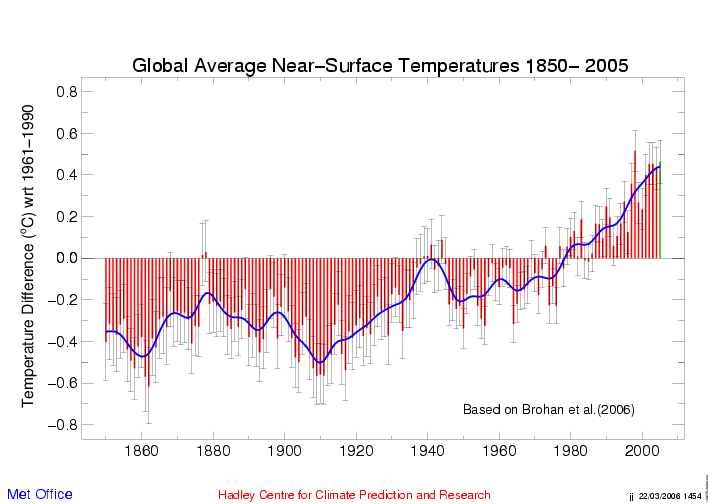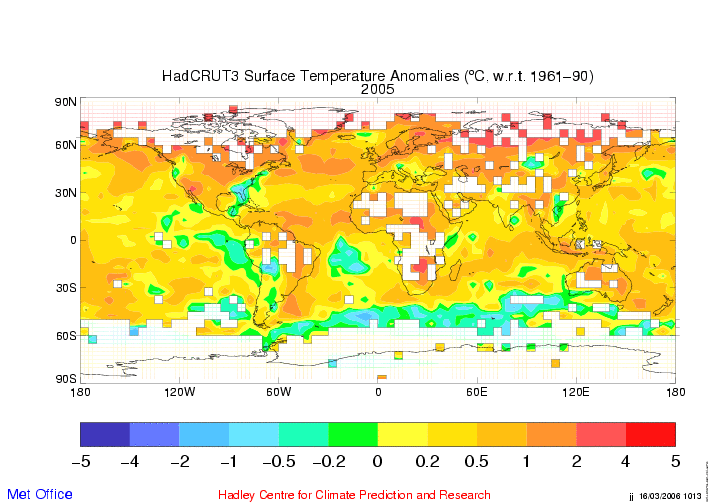We will now take a look at the temperature record since 1860. This record is constructed from actual measurements and thus can be considered reasonably accurate. According to the first figure below, the global average surface temperatures on Earth have risen by about 0.8°C (1.4°F) since 1860. The red bars indicate the global average temperature each year relative to the average temperature over the period 1961-1990. The blue line is a smoothed version of the plot drawn to highlight trends in temperature. There is some uncertainty in determining global average temperatures from the available measurements due to instrumental errors and the fact that measurements are quite sparse over some areas of the world, but even the most conservative estimates indicate that the surface temperature has risen at least 0.5°C (0.9°F) since 1860.
The second figure below shows the temperature differences for the year 2005 compared to the 1961-1990 average temperature. Even though the average global temperature for 2005 was about 0.45°C higher than the 1961-1990 average, note that some regions of the world showed much larger warm anomalies (over 4°C in some areas), while other regions actually had lower temperatures (over 1°C in some areas) for the year 2005. This again shows that even if the global average temperature goes up, there will be quite a bit of variability on regional scales.


We need to answer the question: Is the recently measured warming of global average surface temperatures caused by the increasing amounts of greenhouse gases in the atmospere, or is it part of a natural cycle?
According to climate models the warming is largely due to the additional greenhouse gases. If greenhouse gas concentrations are left fixed at pre-industrial levels, the models show little if any warming during the twentieth century, while the same models do predict warming when they include the observed increases in greenhouse gases. However, most models are unable to reconstruct the irregular pattern of the observed warming since 1860.
The irregular warming has been used by global warming opponents as evidence that natural climate fluctuations dominate over the effects caused by increased greenhouse gases. In particular, they point to two periods:
Proponents of global warming contend that even during the general warming trend expected as greenhouse gases increases, there will be fluctuations along the way. The cooling period from 1940-1970s can possibly be explained by high aerosol concentrations in the atmosphere during this period related to "dirty" coal burning. "Dirty" coal burning has since been curtailed due to concerns about acid rain. Once the aerosols cleared, we started to again see global warming caused by increasing greenhouse gases.
Based on the historical temperature record, the warming since 1980 appears to be the fastest rate of increase over the last 10,000 years. Including 2005, the warmest 12 years in the measured temperature record (since 1860) have been recorded since 1990. For many, this is enough evidence that the recent temperature increases are not part of some natural cycle, and must be due to human activity, caused by increasing greenhouse gas concentrations in the atmosphere.
However, if we go back 500 years to the Medieval warm period (or Little Climatic Optimum), current global average temperatures may be only slightly warmer than that period. The biggest difference today is that the rate of warming (0.8°C in 100 years) is much faster than the rate of warming that lead up to the Medieval Warm Period. And perhaps more significantly, the rate of increase from 1980 through today is much faster than that and shows no signs of slowing.
The global warming issue has been labeled the "Science of Uncertainty": (1)Although we are able to measure a significant rise in global average temperatures in recent years, we are unable to determine how much of the warming is due to the increases in greenhouse gases and how much is part of some natural cycle; (2)We are unable to predict exactly how climate will change in the future with higher levels of greenhouse gases and exactly what the impacts of climate changes will be on humans and other life on the planet. This makes it difficult for all people to come together and agree on what, if anything, should be done. Scientists are working on reducing the uncertainties, but due to the complex nature of the climate system, we should not expect certain answers to all questions. We have to make decisions which weigh uncertain risks against the costs of taking action.
If nothing else, the human race is in the process of performing a huge experiment on global climate by increasing greenhouse gas concentrations. The concentration of carbon dioxide in the atmosphere is probably greater now than at any time over the last one million years. The outcome of this experiment is uncertain. Are we ready and willing to take the risks? So far the answer is yes, because in spite of all the talk about global warming, the rate of greenhouse gas emissions continue to increase. This is especially relevant for the people of the United States who by far emit more greenhouse gases per person than any other nation on Earth. By the way, if you are one of those people who believe that even though adding greenhouse gases is probably not a good thing, we should wait to deal with the problem until we are more sure that greenhouse gases are causing us problems, you need to keep in mind that there will likely be no "quick fix". Once released into the atmosphere, greenhouse gases remain for quite some time, and there is a significant delay before the complete climate change, at the higher greenhouse gas concentrations, is fully realized.
In accordance with those who believe that we should not take the potential risks associated with climate change here is an interesting comparison between climate change and tobacco use. Still others do not perceive much risk at all. While most global warming sceptics do not deny that the world is getting warmer, they do doubt that human activity is the cause. Some say the changes now being witnessed are not extraordinary - similar, rapid changes can be seen at other times in Earth's history when humans either did not exist or were incapable of effecting climate change. Some point to the Sun's present high activity as the prime influence on recent temperature trends. Nevertheless, there is a growing consensus among climate scientists that, even on top of the natural variability of the climate, something out of the ordinary is happening and humans are to blame.
There are many diverse opinions on how to deal with the global warming issue. Each of us needs to make up our own mind. Are you willing to make sacrifices now to reduce the potential (and uncertain) consequences of global warming? Personal sacrifices would be consciously limiting your activities which release greenhouse gases (like driving or energy usage). Societal sacrifices would be government regulations that force individuals and companies to reduce emissions of greenhouse gases.